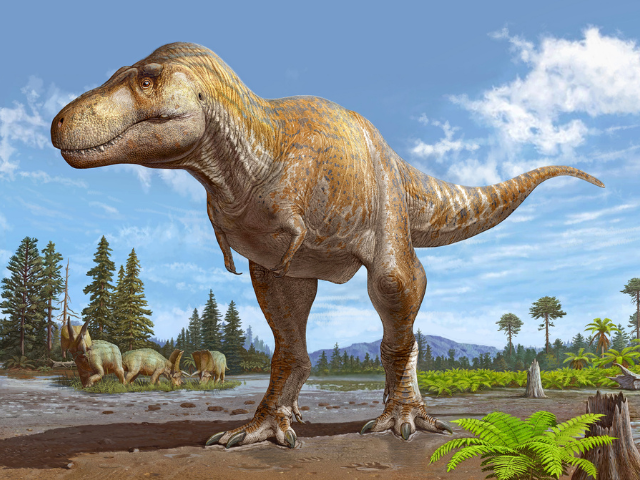
An illustration shows what the recently discovered Tyrannosaurus mcraeensis specimen may have looked like when it roamed the Earth.
CENTER VALLEY, Pa. — The ferocious Tyrannosaurus rex lived between approximately 68 to 66 million years ago, but a team of researchers that includes a Penn State Lehigh Valley professor has identified a new species of Tyrannosaurus that dates back even further — essentially an ancestor of the fearsomely named "tyrant lizard king.” They published their finding in Scientific Reports.
D. Edward Malinzak, assistant teaching professor of biology at Lehigh Valley, is one of the researchers studying the specimen and co-authored the study, which was led by Sebastian Dalman, doctoral candidate at Montana State University. The specimen is no longer referred to as T. rex but by its own species name, Tyrannosaurus mcraeensis. Malinzak said the specific name mcraeensis was chosen in reference to the geologic feature from which the specimen was recovered.
A group of people discovered the specimen — a nearly complete lower jaw — while canoeing on a lake in Elephant Butte in south-central New Mexico in the early 1980s.
“The lower jaw was lying down along the edge of the lake. Eventually the specimen was donated to the New Mexico Museum of Natural History and Science (NMMNH),” Dalman said. “More bones of this Tyrannosaurus were found by the field crew from NMMNH in the late 1990s.”
Thought to be a T. rex at first, further analysis has shown the specimen is actually older than the T. rex.
“It was referred to T. rex first; however, recent radioisotopic dating of the stratigraphic unit in the Hall Lake Formation in which Tyrannosaurus mcraeensis was found show an age of 74 million years,” Dalman said. “It’s really an ancestor of the T. rex in North America. It was believed the T. rex came from Asia, but it looks like they went from North America to Asia and not the other way.”
Discovering and researching the specimen was very much a team effort, according to Malinzak, who joined the project in 2019.
“I met up with [Dalman] in South Dakota and started talking, and I asked if anyone was doing paleobiogeographic work,” he said. He later connected with the team from the NMMNH and became part of this project. “People thought it was T. rex all this time, but if you look at everything in the whole picture, it doesn’t really come close. With the time gap, there is a temporal difference between the species. It gives us some extremely important information — it’s the origin story for T. rex.”
Malinzak's contributions to the work focused on comparing the specimen against other closely related tyrannosaurs to better understand the way in which the structure and shape of the jaw differed from other tyrannosaur species.
“I also contributed to the discussion of the specimen in terms of paleobiogeography and evolutionary implications," said Malinzak, who previously conducted work related to Laramidia, an ancient continent comprising the western half of modern-day North America from Alaska to Mexico. "Through several back-and-forth conversations regarding various aspects [of the research process], we were able to synthesize a hypothesis as to the evolutionary implications this specimen/taxon might have in our understanding of ... evolutionary history and specifically the evolution of Tyrannosaurus.”




